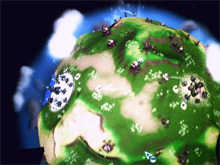Gaming Podcast’s Jonah Falcon and Shack News’ T.J. Denzer do a totally-not-ripping-off-Zero-Punctuation’s-Let’s-Drown-Out video of the former playing Viscera Cleanup Detail as they discuss how depressing the announcement of the Electronic Arts/NFL exclusive license extension is, promising more awful Madden titles.
VIDEO: GamingPodcast Plays Viscera Cleanup Detail
Related Post
Episode 694: Baldur’s StarfieldEpisode 694: Baldur’s Starfield
As Starfield readies its launch, Baldur’s Gate 3 gets a ton of updates.
The news includes:
- Star Wars: Dark Forces is getting the Nightdive remaster treatment
- Xbox must have mobile presence if it’s going to thrive, Phil Spencer says
- No Man’s Sky adds its first new race in its biggest update of the year
- Citizen Sleeper 2 announced
- League of Legends is ditching Mythic items
All this and Listener Feedback.
Spore Generates Buzz: 500,000+ User CreaturesSpore Generates Buzz: 500,000+ User Creatures
 Although I would have thought different, apparently people are clamoring over the “hype generator” tool called Spore Creature Creator. “The best part is that these creatures will be part of the main game, Spore, as user content will populate a lot of the galaxy in each player’s game,” says Falcon at GameStooge.
Although I would have thought different, apparently people are clamoring over the “hype generator” tool called Spore Creature Creator. “The best part is that these creatures will be part of the main game, Spore, as user content will populate a lot of the galaxy in each player’s game,” says Falcon at GameStooge.
Will Wright and the team driving the Spore game is right on target to create the hype needed to send this game into the top game seller. If TheSims woke us up to crazy sales figures, Spore might just beat the demand; imagine creating a tool to help create a world for your company and make money while doing it?
The Creature Creator, in my mind is a genius move to get people interested in the main title and drive pre-sales figures through the roof.
(Thanks, GameStooge)
Episode 769: Our UndertalesEpisode 769: Our Undertales
The guys talk about Dave the Diver finally arriving on Xbox Series X/S, Krafton CEO allegedly asking AI to “brainstorm ways to avoid paying” earnout bonus to Subnautica 2 devs and the Xbox Partner Preview.
The Gaming Flashback is the indie megahit Undertale.
More news:
- Cities: Skylines development moves to Iceflake Studios (from Shacknews)
- Marathon playtest is coming in December
Let us know what you think.
Podcast: Play in new window | Download
